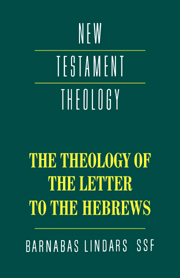3 - Hebrews and the New Testament
Published online by Cambridge University Press: 03 February 2010
Summary
UNITY AND DIVERSITY
Hebrews is a unique strand in the cord of early Christian literature. It comes from a church which cannot be identified with any of the churches represented by the other books of the New Testament. It has no direct literary links with the Synoptic Gospels, the Lukan writings, the Pauline Letters, the Johannine literature, the Pastoral and Catholic Epistles, and Revelation. On the other hand there are echoes of all these writings, however faint, inasmuch as all stem from the rise of Christianity as a distinct movement of people who acknowledge Jesus as Messiah and Lord. What binds the New Testament together is the common base in the confession of faith in Jesus. The primitive preaching of it was closely related to Jesus' own proclamation of the kingdom of God, and was presented in a form appropriate to the Jewish audience from whom the apostles themselves were drawn. As Christianity grew and spread beyond the confines of Judaism, inevitably there was development of doctrinal statement, and the social fragmentation led to differences of emphasis and modifications and additions in the light of local needs and new problems which had to be faced. This is the reason for the distinctive character of Hebrews itself.
- Type
- Chapter
- Information
- The Theology of the Letter to the Hebrews , pp. 119 - 127Publisher: Cambridge University PressPrint publication year: 1991



